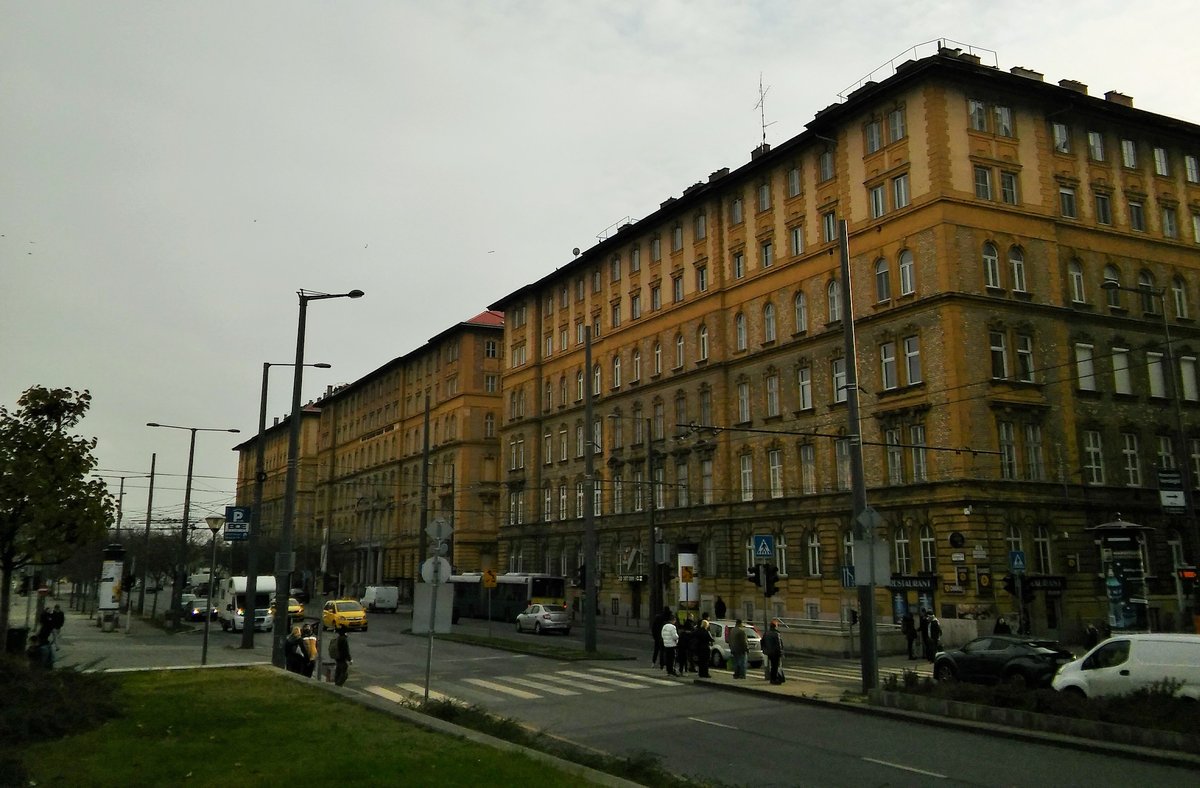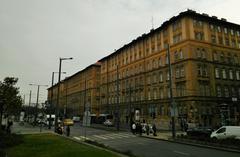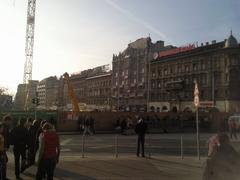
Baross Tér Budapest: Visiting Hours, Tickets, and Historical Sites Guide
Date: 14/06/2025
Introduction to Baross Tér, Budapest
Baross Tér, located in Budapest’s dynamic 8th district (Józsefváros), stands as a pivotal intersection of the city’s history, culture, and contemporary urban life. Most renowned as the home of Keleti Pályaudvar (Eastern Railway Station)—an architectural and transportation landmark—Baross Tér functions as both a bustling transit hub and a gateway to Budapest for international and domestic visitors alike. Established in the late 19th century and named to honor Gábor Baross, Hungary’s influential “Iron Minister” of Transport, the square epitomizes Budapest’s evolution from the Austro-Hungarian era through modern revitalization.
Today, Baross Tér offers 24/7 access to its public spaces, with seamless connections to metro, bus, and rail networks, as well as inclusive design features for travelers with varied mobility needs. Its central location makes it not only a transit interchange but also a launching point for cultural exploration, local events, and guided tours, making it a must-see for any Budapest itinerary (Budapest City Guide, WiseVisitor, Építészfórum, Travelling Mandala).
Contents Overview
- Introduction
- Historical Overview
- Visitor Information
- Getting There & Accessibility
- Facilities and Services
- Events, Tours & Photographic Spots
- Practical Tips for June
- Nearby Attractions & Recommended Itineraries
- FAQ
- Conclusion & Call to Action
- Sources
Historical Overview
Origins and Early Development
Baross Tér emerged during Budapest’s rapid growth after the 1873 unification of Buda, Pest, and Óbuda. Named after Gábor Baross, the reformist Minister of Transport, the square was designed as the grand forecourt to Keleti Pályaudvar. Opened in 1884 and designed by Gyula Rochlitz and János Feketeházy, Keleti quickly became Budapest’s primary international railway gateway, symbolizing Hungary’s modernization (Budapest City Guide).
Urban Transformation and Architecture
Through the late 19th and early 20th centuries, Baross Tér was reshaped with electric trams, broad boulevards, and eclectic architecture. The neoclassical Keleti Station stands as a monumental centerpiece, surrounded by grand hotels and bustling cafés—testaments to Budapest’s emergence as a European metropolis (Hampage Tram History).
20th Century Challenges and Renewal
The square witnessed significant wartime damage and was a flashpoint during the 1956 Hungarian Revolution (Wikimedia Commons: 1956 at Baross Square). Post-war, the area faced urban congestion and decline. A major renewal project completed in 2014 modernized Baross Tér with improved transport facilities, pedestrian zones, and green spaces, showcasing Budapest’s commitment to sustainable urban design (Hungarian Government News).
Visitor Information
Visiting Hours
- Baross Tér: Open to the public 24/7.
- Keleti Railway Station: Generally open from 3:45 am to midnight, with ticket offices and indoor facilities operating roughly from 5:00 am to 10:00 pm (WiseVisitor).
Ticket Information
- Baross Tér: Free public access; no entrance fee.
- Transport: Tickets required for metro, bus, trolleybus, and train services. Purchase at machines, ticket offices, or via the BudapestGO app (BKK).
- Guided Tours: Various operators offer historical and architectural tours including Baross Tér and Keleti Station. Advance booking is recommended.
Accessibility
- Ramps, elevators, and tactile paving at Keleti Station and throughout Baross Tér ensure accessibility for travelers with disabilities. Recent renovations have further improved mobility and signage (Budapest.city).
Getting There & Orientation
Location
Baross Tér sits at the intersection of major arteries—Rákóczi út, Thököly út, Rottenbiller utca, and Fiumei út—in District VIII, adjacent to Keleti Pályaudvar (Wikipedia).
By Public Transport
- Metro: M2 (red) and M4 (green) both stop at Keleti pályaudvar beneath the square.
- Bus: Numerous city and regional lines (e.g., 7, 8E, 20E, 30, 110, 112, 178, 133E) serve Baross Tér (BKK Timetables).
- Trolleybus: Lines 76, 78, 80, among others, stop nearby.
- Train: Keleti is a hub for international and domestic rail travel.
- Airport: The 100E Airport Express links Budapest Airport with Baross Tér every 20–30 minutes (BKK).
- Bike: MOL Bubi bike-sharing stations are close by.
By Car or Taxi
Parking is limited; public transport is strongly recommended.
Facilities and Services
- Ticketing: Metro, bus, and train tickets available at machines, offices, and online.
- Restrooms: Located in the underpass and inside Keleti Station; a small fee may apply.
- Luggage Storage: Lockers and staffed storage available at Keleti.
- Shops & Food: Newsstands, bakeries, fast food, cafés, and convenience stores in the underpass and station.
- ATMs & Currency Exchange: Multiple options in and around Keleti.
- Wi-Fi: Free in Keleti and some public areas.
Events, Tours & Photographic Spots
- Annual Events: Hosts initiatives like European Mobility Week and Car Free Day, highlighting sustainable urban living (Hungarian Government News).
- Guided Tours: Many Budapest city tours include Baross Tér and Keleti Station, focusing on history, architecture, and railway heritage.
- Photo Opportunities: Capture Keleti’s grand façade, the Gábor Baross Statue (originally erected in 1898 and restored in 2013), and the lively urban scene.
Practical Tips for June Visitors
Weather
- Temperature: 25–33°C (77–91°F) daytime, 15–16°C (59–61°F) nighttime.
- Rainfall: 8–13 rainy days, ~46 mm total; pack an umbrella or light raincoat.
- Daylight: ~16 hours, sunset around 8:30 pm.
- UV Index: High in June—use sunscreen and stay hydrated (Travelling Mandala, EaseWeather, Weather25).
Seasonal Atmosphere
Baross Tér is lively in early summer, with outdoor cafés, bakeries, and extended daylight hours. The square is a popular starting point for city exploration, and nearby City Park (Városliget) offers green space for relaxation (All Things Budapest).
Local Events in June
- Danube Carnival (June 6–14, 2025): Folk dance and music across the city, easy to access via metro from Baross Tér (Headout).
- Museum Night: Late-night access to museums, with many sites easily reached by metro.
- Thermal Bath Sparty Parties: Music and lights at Széchenyi Baths on weekends.
- Open-Air Concerts: Held in nearby squares and parks (Budapest Travel Tips).
What to Wear
- Light, breathable clothing for daytime; sweater or cardigan for cooler evenings; umbrella or rain jacket for showers; sunglasses and hats for sun.
Safety
- Baross Tér is generally safe with a visible security presence, but remain vigilant for pickpockets in crowds.
- Carry water and sunscreen during hot, sunny days.
Nearby Attractions & Recommended Itineraries
- Keleti Pályaudvar: Explore the neoclassical railway station and its architectural details.
- Baross Gábor Statue: Commemorating the square’s namesake, adjacent to the station (budapestcity.org).
- City Park (Városliget): Home to Széchenyi Thermal Bath, Vajdahunyad Castle, and Budapest Zoo.
- Jewish Quarter and Ruin Bars: Vibrant nightlife and cultural scene within walking distance.
- Hungarian National Museum: A 15-minute walk or short metro ride.
Frequently Asked Questions (FAQ)
Q: What are the opening hours of Baross Tér and Keleti Station?
A: Baross Tér is open 24/7; Keleti Station operates from about 3:45 am to midnight.
Q: Is there an entrance fee to Baross Tér?
A: No, entry is free. Tickets are only needed for using public transport.
Q: How do I get to Baross Tér from the airport?
A: Take the 100E Airport Express bus directly to Keleti pályaudvar.
Q: Is Baross Tér accessible for travelers with disabilities?
A: Yes, with elevators, ramps, and tactile paving in the square and station.
Q: Can I join a tour of Baross Tér?
A: Many walking tours include Baross Tér and Keleti Station as highlights.
Q: Where can I store luggage?
A: Keleti Station offers lockers and a staffed luggage room.
Visuals and Media Suggestions
- Photos: Keleti Station façade, Baross Gábor Statue, bustling square.
- Maps: Showcasing Baross Tér’s central location and transport links.
- Virtual Tours: Explore Baross Tér and Keleti online via Budapest City Guide.
- Images:
Conclusion & Call to Action
Baross Tér is a vibrant reflection of Budapest’s past and present—a transport hub, historical landmark, and cultural crossroads. With free public access, comprehensive transport connections, and proximity to must-see sites, Baross Tér is essential for any traveler in Budapest. Plan ahead, use digital resources like the BudapestGO and Audiala apps, and immerse yourself in the city’s summer events and everyday life.
For enriched experiences, download the Audiala app for guided tours and real-time travel tips. For updates and more helpful guides, follow us on social media and check our blog.
Sources and Further Reading
- Budapest City Guide
- WiseVisitor
- Építészfórum
- Travelling Mandala
- BudapestCity.org
- Headout
- All Things Budapest
- Budapest Travel Tips
- EaseWeather
- Weather25
- BKK









































































































































































